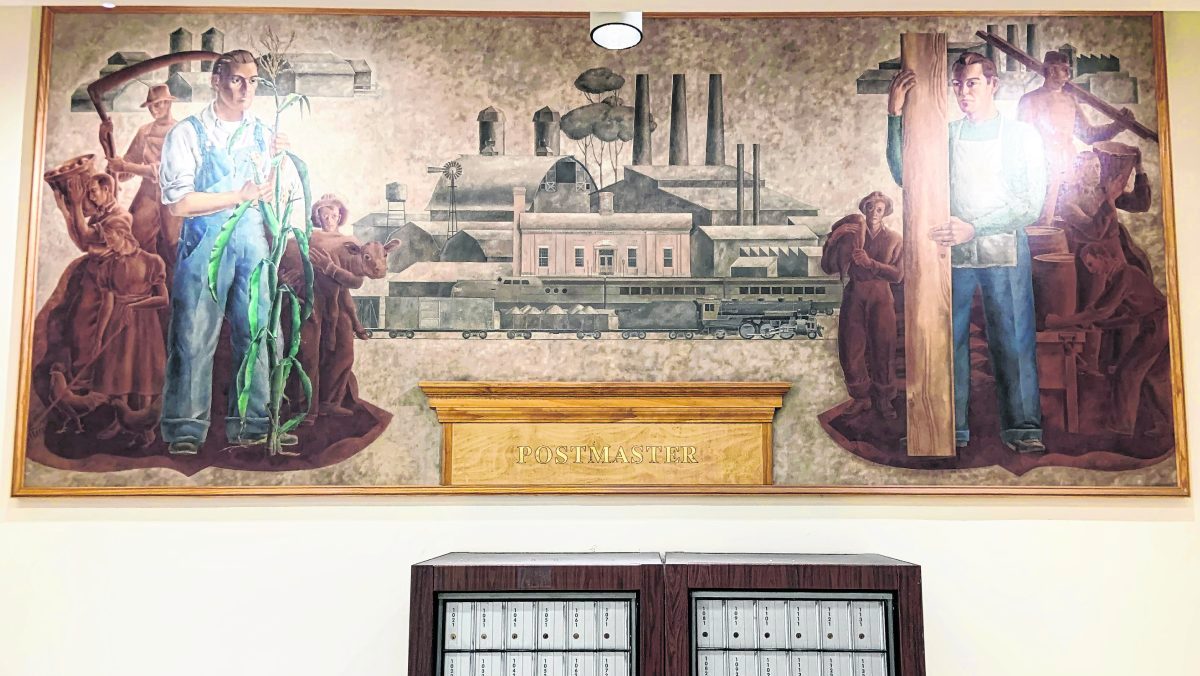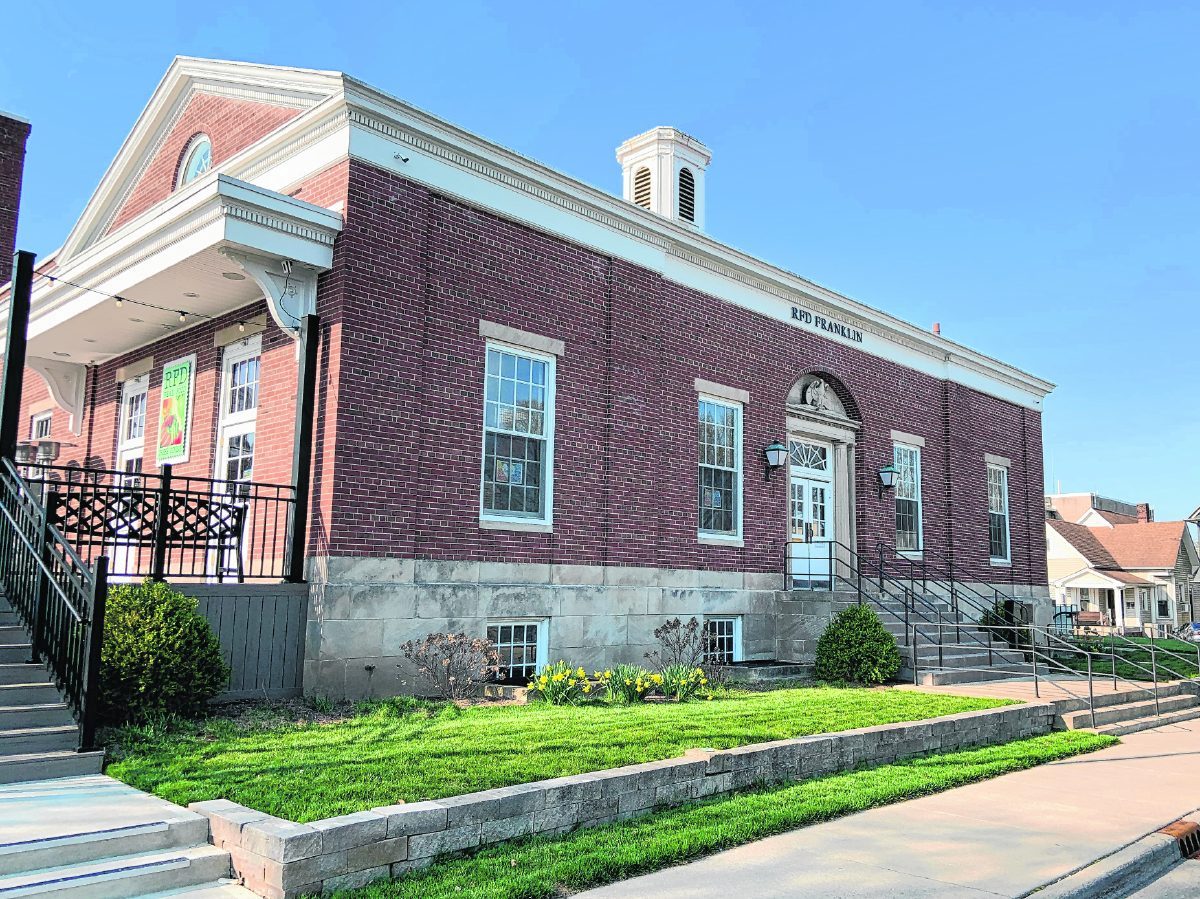

Walking through the door of Franklin’s post office, nearly everyone turns right to wait in line to mail packages, buy stamps and do other business.
So it makes sense that very few people ever encounter the historic work of art waiting the other direction. But there it hangs: a wall-sized mural depicting farmers, workers, transportation and businesses. A farmer stands on the left side and a carpenter on the right, with secondary art of men and women engaged in agriculture and industry.
At the center, barns and factories speak to the twin aspects of Johnson County life. It also features two trains moving in opposite directions, one an antiquated engine and the other a 1930s-style one.
The piece, titled “Local Industry,” created in Franklin by Jean Swiggett, a Franklin native, was finished in 1940 as part of a New Deal program providing work for artists.
“It definitely looks back at that era of the New Deal and the Great Depression, looking at the struggles we went through and the fact we were able to get out of that time in our history,” said David Pfeiffer, director of the Johnson County Museum of History.
In the midst of hardship, artists were hired to paint murals unique to the communities that were building new post offices. The wall-sized works of art captured local traditions, the spirit of the community and the people who occupied them. In Indiana, 38 post offices were chosen to receive murals, sculptures or other artwork. One of those was “Local Industry.”

Originally hanging in the former post office building on Madison Street, the mural has since been moved to the current building on Main Street. Though not many people know it is even there, the mural represents an important part of the county’s history.
“When I go to the post office, I always turn right and go into where the counter is. I went left past all of the PO boxes, and there’s this beautiful mural there,” Pfeiffer said.
The Franklin mural came about through a federal program created during the Depression. Harry Morgenthau Jr., treasury secretary in the 1930s, created the Section of Painting and Sculpture, later the Section of Fine Arts, as a program of public art works to help support unemployed artists and beautify government buildings.
“The aim is to secure murals and sculpture of distinguished quality appropriate to the embellishment of Federal Buildings,” according to a 1938 news release from the Section of Fine Arts
Artists were “encouraged to visit the community and discuss subject matter with leading citizens,” according to the Federal Works Agency. Through anonymous competitions and later invitations by officials, designs were chosen for projects such as the U.S. Department of Interior headquarters in Washington, D.C.
But post offices were the primary focus of the murals and other artworks, said David W. Gates Jr., an author and photographer who specializes in post offices. Gates has written guidebooks and full catalogs of all the New Deal post office murals in Tennessee and Wisconsin. The goal is to write a book on each state’s murals, he said.
“They were created during a pivotal moment in our nation’s history. A lot of programs that were done at that time, a lot of that stuff was done to employ people and put them to work,” he said. “The building and construction of the post offices, and the employment of artists during this time, was life-saving for a lot of these people.”
His interest in post offices started as a way to remember all the small towns he passed through on his travels. Years later, he learned more about the post office artwork program.
Tracking down and documenting the different murals opened his eyes to the breadth of the program.
“The topics and ideas and themes all varied based on the locality of that particular building,” Gates Jr. said. “They’re not all murals, either. There were wood carvings, plaster casts, metal stampings, things like this.”
Hundreds of post office murals were created across the United States, according to the Living New Deal, a nonprofit group researching, presenting and educating on public works from the New Deal. Through intrepid research and digging into government archives, the organization had cataloged all kinds of public projects completed during the 1930s.
Like the post office artworks, many of those projects have a lasting impact on our daily lives, said Susan Ives, communication and events manager for the Living New Deal.
“The New Deal touched every state, city, rural area in the country despite the political persuasion. A lot of what the New Deal built, we are still using today. It makes you wonder, why aren’t we doing it now?” she said.
Indiana received its first two in 1936, when artist Henrik Martin Mayer painted two in Lafayette.
The murals had much in common, though designs varied from community to community. Some designs included real people from the community, such as the work at Crown Point’s post office, “From Such Beginnings Sprang the County of Lake, Indiana,” by George Melville Smith. Smith centered the painting around Solon Robinson, the city’s founder, and Chief Mewonitoc, an area Native American leader.
Many of the murals incorporated symbolic representations of American citizens, such as farmers, industrial workers and pioneers, Gates said. This is the focus of the Franklin painting.
“Local Industry” was created by artist Jean Swiggett, who had been born in Franklin but moved to California as a child. He went on to enjoy a lengthy art career, painting on more than 40 murals in Arizona, California and Indiana.
In the 1930s, Swiggett was living and working in Long Beach when he won a commission from the Treasury Department to paint the mural in 1939.
In a Daily Journal story from Aug. 13, 1988, Swiggett said the original drawing for the mural was done not for Franklin but for a different, similar town. Though his design was not chosen for that particular town’s post office, Treasury officials did ask him to provide one for Franklin.
The city had just built a new post office through the Works Progress Administration, and a mural was needed for it.
“It was a fairly new post office at the time, and that helped to get them to the top of the list,” Pfeiffer said. “They were looking for what they called embellishments to spruce up these buildings. And it was a way to give struggling artists some work, and give the public some art to look at.”
Because he was just 2 years old when he moved and didn’t remember Franklin, Swiggett researched it and found that his original design could be modified.
He retained the themes of farmers and workers, barns and factories. But as the focal point, Swiggett also painted the Franklin Post Office building, a rarity for these types of murals, Pfeiffer said.
“Ours is a little bit unique for that. Most of the murals were more generic Americana, and this one was able to highlight the actual post office building,” he said.
For more than 45 years, the mural was situated in the lobby of the post office in downtown Franklin. When the new post office opened in the early 1980s on North Main Street, the mural was moved as well.
But hidden in the corner, few people are aware it even exists, Pfeiffer said.
“If you didn’t know about the mural, tucked away in an obscure corner of the post office,” he said. “A lot of people have missed out for it.”
[sc:pullout-title pullout-title=”At a glance” ][sc:pullout-text-begin]
New Deal post office murals and artwork
What: A program, created by the U.S. Treasury Department in the 1930s, called the Section of Painting and Sculpture, later the Section of Fine Arts. The program of public art works to help support unemployed artists and beautify government buildings.
When: 1934 to 1942
Indiana post office murals
- Franklin
- Hobart
- Crown Point
- Rensselaer
- Monticello
- Culver
- Nappanee
- North Manchester
- Ligonier
- Middlebury
- Lagrange
- Angola
- Garrett
- Union City
- Dunkirk
- Gas City
- Alexandria
- Tipton
- Pendleton
- Knightstown
- Cambridge City
- Broad Ripple Station
- Danville
- Fowler
- Lafayette
- Attica
- Crawfordsville
- Rockville
- Spencer
- Martinsville
- Batesville
- Liberty
- Aurora
- Bloomfield
- Bedford
- Paoli
- Jasper
- Boonville
Information: livingnewdeal.org
[sc:pullout-text-end]




